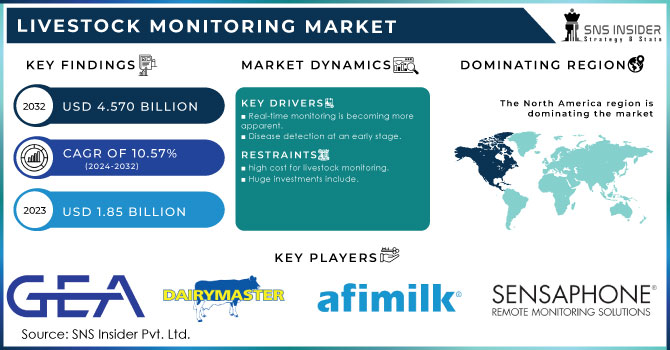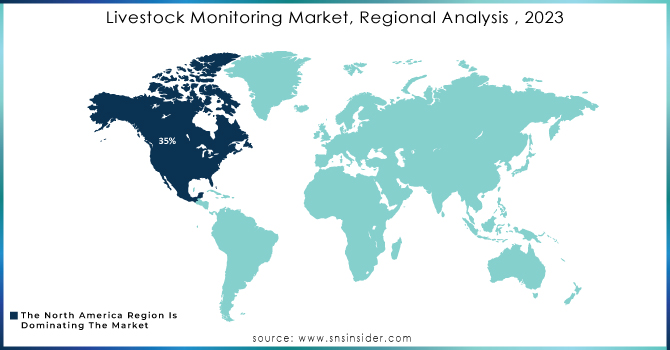Livestock Monitoring Market Size & Growth:
The Livestock Monitoring Market Size was valued at USD 2.78 billion in 2023 and is expected to reach USD 6.40 billion by 2032, growing at a CAGR of 9.75% over the forecast period 2024-2032. Enhanced technology adoption across all scales of farms is driving the growth of the Livestock Monitoring Market. There is an upward trend in adoption as farmers make use of IoT, artificial intelligence (AI), and sensor-based systems for health monitoring and productivity optimization. With AI solutions that analyze data for advertising and direct response marketing decisions becoming popular, hardware and software segments are booming in the current market. Moreover, these optimized sensors are gathering more accurate information on livestock health and behavior, and are performing better. It also includes the rise of cross-technology use in which integrated systems merge monitoring with on-farm management tools to optimize overall operational performance.

Get more information on Livestock Monitoring Market - Request Sample Report
Livestock Monitoring Market Dynamics
Key Drivers:
-
Driving Growth in Livestock Monitoring Market through Automation Precision Farming and Advanced Disease Detection Solutions
The growth of the livestock monitoring market is primarily driven by robust demand for automation and precision farming in the agricultural sector. As the world consumes more and more meat and dairy, farmers are looking for smart technologies IoT-based sensors, AI-powered analytics, and wearable trackers that can drive productivity and improve animal health. In addition, rising apprehensions regarding livestock diseases along with the rising requirements for early disease detection are propelling the adoption of health and behavioral monitoring solutions. Moreover, the digital transformation of agriculture supported by government initiatives and rising investments in AgTech startups will drive the market in the upcoming years.
Restrain:
-
Restrain in Livestock Monitoring Market Include High Costs Technological Barriers Connectivity Issues and Data Security Concerns
The high-cost investment to adopt an advanced monitoring system is one of the restraining factors for the market. IoT technology, automated milking machines, AI-based monitoring, or sensors for tracking livestock herds are too costly for many small and medium-sized farmers, especially in less developed countries. There is also a low level of technological awareness and digital literacy among farmers that minimizes large-scale adoption. These remote and rural areas have extensive connectivity issues, making it challenging to collect and analyze data in real-time, thus contrasting the effectiveness of precision livestock management. A further challenge is that the use of cloud-based and AI-driven monitoring solutions puts those farms in the firing line of cyber threats and data breaches, raising concerns over data security and privacy.
Opportunity:
-
Opportunities in Livestock Monitoring Market Grow with AI Blockchain Smart Farms and Rising Consumer Demand
As the livestock supply chain embraces AI-driven Predictive Analytics and Blockchain for traceability, opportunities in this market have blossomed. In the era of connected farms and smart dairy solutions, the opportunities for sophisticated livestock management systems are also increasing. Increasing consumer demand for organic and antibiotic-free meat is also promoting precision feeding and breeding technologies so that farmers can produce food of high quality to meet sustainable production targets. Emerging markets of Asia-Pacific and Latin America are estimated to own high growth opportunities; growing livestock farming activities accompanied with government policies that support smart animal agriculture.
Challenges:
-
Challenges in Livestock Monitoring Market Include Integration Issues Environmental Impact Resistance to Technology Adoption
The challenge is the integration and interoperability across various environmental monitoring systems. The challenge is that different manufacturers offer livestock monitoring solutions that use proprietary technologies, which makes it hard to build a unified digital farm-management platform that could be as widely adopted as the smartphone. Further, environmental factors can impact the accuracy and reliability of data, resulting in wrong insights and decisions. Market penetration is further prevented due to resistance to technology adoption amongst conventional farmers and scantily skilled personnel to effectively operate and manage these digital solutions. Addressing these challenges will need greater awareness, funding, and the development of affordable, simple, and scalable solutions for smallholder farmers.
Livestock Monitoring Market Segment Analysis
By Component
The livestock monitoring market was led by hardware with a 40.7% share in 2023 since tools are foundational monitoring devices that include wearable sensors, RFIDs, automated milking systems, and GPS-enabled tracking devices. These hardware solutions play a vital role in collecting real-time data on livestock health, behavior, and productivity. Hardware demand has also been driven by the rising adoption of smart collars, ear tags, and biometric sensors that allow for disease detection and performance tracking. Further, depending upon the infrastructure such as cameras, the weighing system proves helpful in the management of the farm, which is why it contributes a significant share of the market.
Software will likely experience the highest CAGR from 2024-2032, because of the rising demand for data analytics, cloud integration, and AI-powered decisions. Due to huge quantities of data produced by IoT sensors on farms, software solutions to predictive analytics, automated alerts, and precision livestock management are essential. Quick software adoption facilitated by the trend towards AI-enabled herd management and blockchain-based traceability solutions is making it possible for farmers to maximize output and increase productivity.
By Type
In 2023, the bovine segment accounted for the largest share of 48.2% of the livestock monitoring market. This is attributed to the economic significance of dairy and beef cattle farming. The growing global consumption of milk, meat, and other dairy products has led to huge investments in sophisticated monitoring solutions for herd health, breeding, and milking productivity. Technologies such as RFID tags, automated milking systems, and wearable health trackers are widely adopted by farmers to increase productivity and mitigate disease-related losses. Moreover, the domination of the bovine sector is further supplemented by government policies for smart dairy farming and precision livestock management.
The poultry segment is predicted to register the highest CAGR during the forecast period from 2024-2032, owing to the increase in poultry consumption, globally, and the growing demand for effective production control. Automation-based monitoring of poultry, AI-enabled disease detection, and precision feeding solutions for enhanced yield and biosecurity are rapidly being accepted in the poultry sector. Software-driven poultry monitoring is becoming a major focus as well, due to the increasing integration of cloud-based platforms for real-time tracking and predictive analytics in large-scale poultry farms, and this also contributes to the rapid growth of the market.
By Application
Milking management held the largest market share of 21.7% in the livestock monitoring market in 2023 owing to the rising demand for automated milking solutions in dairy farms. As the world consumes more milk, dairy farmers are adopting precision technologies, including robotic milking systems, automatic milk analyzers, and IoT-enabled monitoring devices, to increase milk production, productivity, and quality. This trend is further strengthening the market position of the segment, due to the rapidly increasing implementation of sensors for udder health tracking and real-time milk production analysis. In addition, smart dairy farming and precision livestock management promoted by various governments also improved the uses of the milking management system.
The behavioral monitoring segment is projected to dominate the growth from 2024-2032 with the growth owing to rising demand for livestock welfare and disease detection at an early stage. Farmlog provides ranchers a way to track livestock on farms that are near the head, making tracking livestock movement easier along with the use of AI-driven track systems tracking wearable sensors, and smart cameras for monitoring livestock feeding and stress. The increase in demand for predictive analytics in animal health management and stringent animal welfare regulations is resulting in the fast adoption of behavioral monitoring solutions.
Livestock Monitoring Market Regional Outlook
The livestock monitoring market in North America accounted for a 30.4% share in 2023, owing to the high adoption of precision livestock farming technologies in the region. Market growth has been driven by established dairy and meat industries and strong government support for smart farming. IoT-based livestock monitoring has made its way into the U.S. and Canada, as are automated milking and AI-based health monitoring solutions. Take Connecterra a U.S.-based AgTech company that offers a suite of AI-powered dairy monitoring services to dairy farmers to help them optimize their milk production and early detect diseases. Moreover, some firms including Allflex, a subsidiary of Merck, have introduced several RFID and biometric tracking hardware systems that are also popularized among the cattle industries around the region.
Asia-Pacific is projected to be the fastest-growing region during the forecast period (2024–2032) owing to rising livestock farming in countries such as China, India, and Australia. Increased demand for dairy and meat products along with the growing population in the region is driving the need for advanced livestock monitoring solutions. To increase profitability and contain outbreaks of disease, both governments and agribusinesses are investing heavily in smart farming technologies. Chinese tech giant Alibaba, for instance, has launched AI-powered smart farming solutions that allow farmers to monitor livestock health and behavior in real-time. Meanwhile in India, Stellapps is transforming the dairy industry with IoT-based monitoring solutions that enable farmers to create a maximum milk yield and monitor herd health, playing a key role in the significant growth of the market in the region.

Need any customization research on Livestock Monitoring Market - Enquiry Now
Key Players
Some of the major players in the Livestock Monitoring Market are:
-
DeLaval (VMS V300 Milking System, Herd Navigator)
-
GEA Farm Technologies (DairyRobot R9500, CowScout)
-
Afimilk Ltd. (Afimilk MCS, AfiAct II)
-
Allflex Livestock Intelligence (SenseHub, RS420 Stick Reader)
-
Lely International NV (Lely Astronaut A5, Lely Vector)
-
BouMatic (Gemini UP Milking Robot, SmartDairy Activity System)
-
Nedap Livestock Management (CowControl, Pig Performance Testing)
-
SCR Engineers Ltd. (Heatime HR System, HealthyCow24 App)
-
BioChek (Poultry Immunoassay Kits, Swine PCR Kits)
-
Smartbow GmbH (SMARTBOW Ear Tag, Cow Positioning System)
-
Milkline (ML Activity Collars, ML Rumination Sensors)
-
Moocall (Moocall Calving Sensor, Moocall HEAT)
-
Dairymaster Ltd. (Swiftflo Commander, MooMonitor+)
-
HID Global Corporation (Livestock RFID Tags, ID Card Printers)
-
Fancom BV (eYeGrow Pig Weighing System, Fancom Climate Controllers)
Recent Trends
-
In December 2024, DeLaval announced the Milking Automation (MA) Series, featuring advanced automation, real-time data insights, and cloud connectivity to enhance conventional parlor milking efficiency.
-
In November 2024, GEA introduced an AI-driven Body Condition Scoring (BCS) system using CattleEye technology to autonomously assess cow health, optimize feeding, and enhance dairy farm efficiency.
-
In May 2024, Nedap introduced a heat stress detection feature in its CowControl system, helping farmers monitor cow health and optimize conditions to maintain productivity.
| Report Attributes | Details |
|---|---|
| Market Size in 2023 | USD 2.78 Billion |
| Market Size by 2032 | USD 6.40 Billion |
| CAGR | CAGR of 9.75% From 2024 to 2032 |
| Base Year | 2023 |
| Forecast Period | 2024-2032 |
| Historical Data | 2020-2022 |
| Report Scope & Coverage | Market Size, Segments Analysis, Competitive Landscape, Regional Analysis, DROC & SWOT Analysis, Forecast Outlook |
| Key Segments | • By Component (Hardware, Software, Services) • By Type (Bovine, Poultry, Swine, Other Animals) • By Application (Milking Management, Breeding Management, Feeding Management, Health Monitoring, Behavioral Monitoring, Other Applications) |
| Regional Analysis/Coverage | North America (US, Canada, Mexico), Europe (Eastern Europe [Poland, Romania, Hungary, Turkey, Rest of Eastern Europe] Western Europe] Germany, France, UK, Italy, Spain, Netherlands, Switzerland, Austria, Rest of Western Europe]), Asia Pacific (China, India, Japan, South Korea, Vietnam, Singapore, Australia, Rest of Asia Pacific), Middle East & Africa (Middle East [UAE, Egypt, Saudi Arabia, Qatar, Rest of Middle East], Africa [Nigeria, South Africa, Rest of Africa], Latin America (Brazil, Argentina, Colombia, Rest of Latin America) |
| Company Profiles | DeLaval, GEA Farm Technologies, Afimilk Ltd., Allflex Livestock Intelligence, Lely International NV, BouMatic, Nedap Livestock Management, SCR Engineers Ltd., BioChek, Smartbow GmbH, Milkline, Moocall, Dairymaster Ltd., HID Global Corporation, Fancom BV. |

